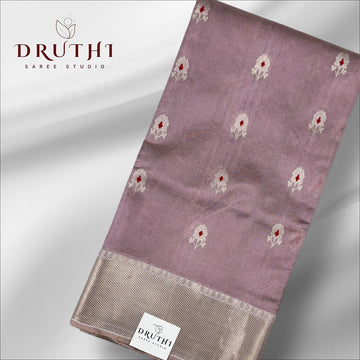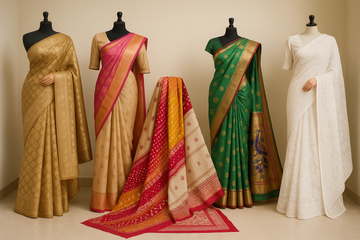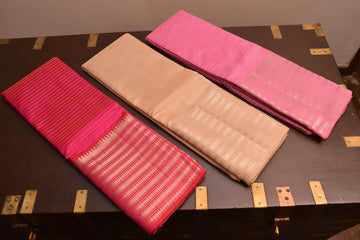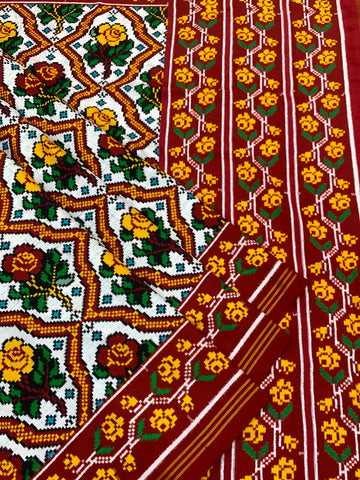💠 Introduction
Among the many handloom marvels India boasts, the Handloom Chanderi Tissue Saree stands out for its sheer elegance, airy texture, and timeless appeal. Known for its luxurious shimmer, lightweight comfort, and traditional weaving techniques, the Chanderi Tissue Saree is not just a piece of clothing—it's a work of art, carrying with it centuries of Indian textile heritage. Popular among women of all age groups, these sarees are now a mainstay for weddings, cultural celebrations, and formal occasions.
This blog explores the rich history, weaving techniques, fabric characteristics, and styling versatility of Chanderi Tissue Sarees, along with insights on why they continue to remain in high demand, especially among saree connoisseurs and fashion-forward women looking for something elegant yet breathable.
🧶 The Origin of Chanderi Weaving
The roots of Chanderi sarees trace back to the town of Chanderi in Madhya Pradesh, which has been an important center for weaving since the 11th century. The town is located at the intersection of ancient trade routes and has been historically recognized for producing fine handwoven fabrics for the royal and noble classes.
The Chanderi Tissue Saree evolved from the traditional Chanderi silk and cotton sarees, combining the ancient craft with modern textile needs. The inclusion of tissue yarns, woven with silk or cotton, adds a reflective finish to the saree, giving it a unique sheen and regal elegance.
✨ What Is a Handloom Chanderi Tissue Saree?
A Chanderi Tissue Saree is a finely handwoven garment using a blend of silk, cotton, and zari tissue threads. The tissue component, often metallic (gold or silver), creates a translucent shimmer, making these sarees ideal for occasions that call for something eye-catching yet graceful.
Key characteristics of Handloom Chanderi Tissue Sarees:
-
Lightweight and breathable
-
Translucent fabric with a soft glow
-
Rich zari borders and pallu
-
Traditional motifs like peacocks, lotuses, coins, and geometric patterns
-
Luxurious feel suitable for weddings and festivals
These sarees are often woven on traditional pit looms by skilled artisans, preserving age-old techniques that have been passed down through generations.
🪡 Weaving Techniques & Materials Used
The magic of handloom Chanderi tissue sarees lies in the interplay of silk warp and cotton or zari weft. The use of high-quality silk threads and ultra-fine cotton gives the fabric its softness, while the tissue yarns lend the saree its iconic shine and sheer texture.
Materials typically used in Chanderi Tissue Sarees:
-
Pure silk warp for strength and structure
-
Mercerized cotton weft for softness and breathability
-
Tissue zari (gold/silver coated threads) for shimmer
-
Natural dyes and eco-friendly techniques for color
Motifs are often handwoven rather than printed, making each saree unique in design. Many sarees also incorporate jacquard weaving techniques for intricate detailing on the pallu and borders.
🎨 Designs & Motifs That Define Chanderi Tissue Sarees
The beauty of a Chanderi Tissue Saree lies not just in its fabric but in its motifs, which are often inspired by nature, architecture, and spirituality. Some common motifs include:
-
Buttis (Small floral or geometric shapes) across the body
-
Peacock and swan motifs on the pallu
-
Chatai (woven mat) patterns on the borders
-
Coin patterns symbolizing prosperity
-
Temple borders that reflect spiritual architecture
Designs are generally woven in zari using gold or silver threads, giving the saree a rich finish that stands out in both natural and artificial light.
💫 Occasions to Wear Handloom Chanderi Tissue Sarees
Handloom Chanderi Tissue Sarees are versatile and suited for a wide range of occasions:
-
Weddings and bridal functions
-
Religious ceremonies and poojas
-
Festivals like Diwali, Sankranti, and Navratri
-
Formal gatherings and office parties
-
Cultural performances and classical concerts
Thanks to their sheer elegance and royal finish, these sarees can be dressed up with traditional jewelry or kept minimal for a modern yet ethnic look.
💃 Why Modern Women Prefer Chanderi Tissue Sarees
With the return to sustainable fashion and traditional weaves, the Chanderi Tissue Saree is experiencing a modern revival. Women today are opting for these sarees not just for cultural wear, but also for their fusion appeal.
Reasons for their growing popularity:
-
Lightweight texture allows easy draping and movement
-
Soft, breathable fabric is comfortable for long hours
-
Sheer elegance gives a royal touch without heaviness
-
Can be styled for both ethnic and Indo-western looks
-
Eco-friendly weaving supports rural artisans and sustainability
Pairing them with contrast blouses, belts, statement jewelry, or modern makeup trends creates a contemporary ethnic statement that is both classy and Instagram-worthy.
📈 Growing Demand & Global Recognition
In recent years, Chanderi Tissue Sarees have been featured in global fashion shows, designer collections, and celebrity wardrobes. The Government of India has also supported Chanderi weaving through GI tagging and handloom development programs, boosting international exports and domestic sales.
The demand for handloom sarees, especially Chanderi silk and tissue sarees, has significantly grown across metro cities like Delhi, Mumbai, Chennai, Bangalore, and Hyderabad. Online marketplaces and boutique stores have made these elegant sarees more accessible to global customers.
🛍️ Buying Guide: How to Choose an Authentic Chanderi Tissue Saree
When investing in a Chanderi Tissue Saree, especially from handloom sources, it's essential to know how to identify quality.
Tips to choose the best one:
-
Check for transparency and shine—tissue sarees have a unique luster
-
Look at the butti work—handwoven ones are slightly uneven, a mark of authenticity
-
Feel the fabric—should be feather-light and soft
-
Check the selvedge and pallu zari work
-
Verify if it’s handloom (not power loom imitation)
Always prefer sarees with a Handloom Mark or those sourced from recognized handloom clusters.
Handloom Chanderi Tissue Sarees
-
Chanderi Tissue Sarees
-
Tissue sarees with zari borders
-
Lightweight Chanderi sarees
-
Traditional handloom sarees
-
Chanderi silk tissue sarees
-
Designer Chanderi sarees
-
Bridal Chanderi tissue sarees
-
Festive wear Chanderi sarees
-
Soft Chanderi silk sarees
🔚 Conclusion
Handloom Chanderi Tissue Sarees are more than just six yards of fabric—they are woven legacies, telling stories of Indian craftsmanship, tradition, and timeless beauty. Whether you are a bride-to-be, a saree collector, or someone simply looking to embrace the elegance of Indian weaves, a Chanderi tissue saree is a graceful addition to your wardrobe. With their soft shimmer, breathable texture, and rich detailing, they represent the perfect harmony of heritage and contemporary style.








